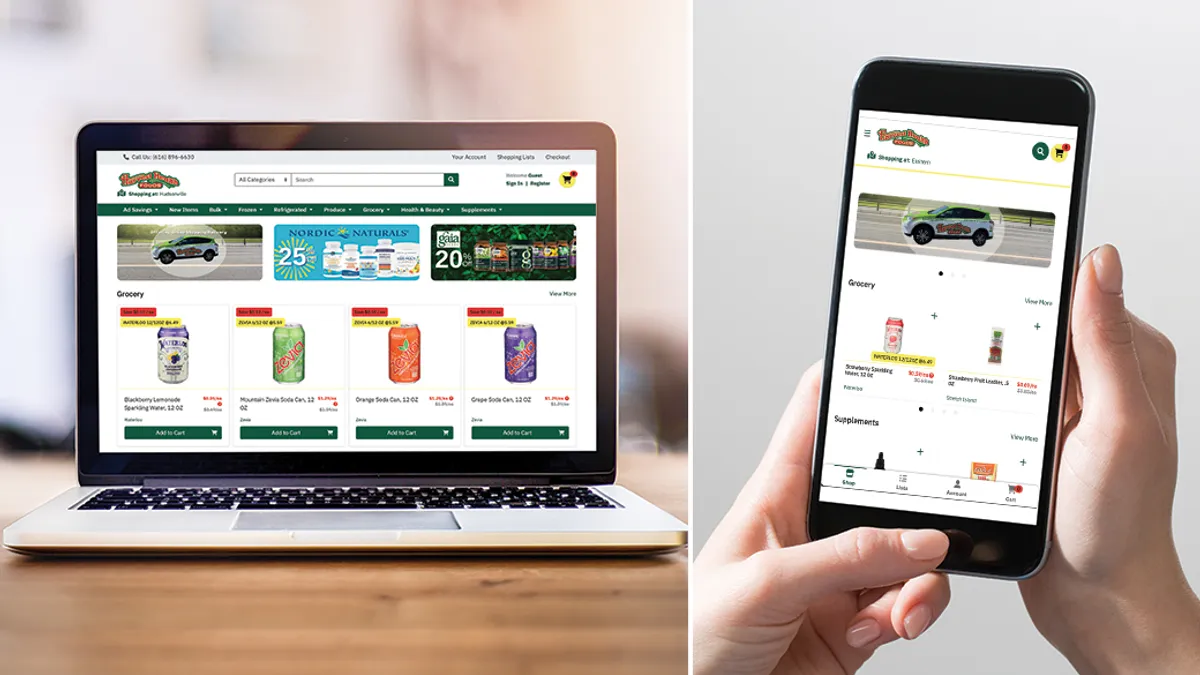In this exclusive webinar interview, Mitchell Nol of Harvest Health Foods takes us on an e-Commerce journey and uncovers creative ways to boost customer adoption and platform profitability with ECRS’ CATAPULT WebCart. Harvest Health is an independent natural grocery and supplements chain based in Grand Rapids, Michigan. Here are the top takeaways from our conversation.
1. There’s value in having an online store, even if they don’t buy anything online.
When we first started with CATAPULT WebCart, we did a soft launch and didn’t announce anything or do any advertising. We just added a button to “Shop Online” on our website. After a couple of days, we were watching Google Analytics and realized that everyone who visits the website clicks the “Shop Online” button. So even if they were not buying anything, they still see what we are all about. It was like an online catalog of what we sell in-store.
2. Implementing WebCart was fast and easy.
You could set up CATAPULT WebCart in a day if you wanted to. Honestly, it was super easy. You just pick your colors and throw some logos and images in there. Everything is already in your database. You don’t have to create a new program or file, export or import anything. That’s the best thing about WebCart: we don’t manage it; the site runs itself. ECRS’ assisted setup program makes the process super easy, and they guide you every step of the way.
3. Clean data helps employees, too.
When implementing WebCart at our store, we focused on cleaning our database first. The last thing we wanted to do was launch all our inventory online without correct images, or not have searchability or incorrect pricing. At the time, we took this upon ourselves, but ECRS now has a database cleaning service just for this process.
After we started editing brand names to increase searchability online, we had a couple of employees come to us and say, “Hey, I don’t know what you guys did, but it is so much easier to search for items in the back office now.” With CATAPULT’s Unified Transaction Logic®, the data you manipulate for WebCart is the same as what populates across all other customer touchpoints. There’s no batching or synching, just one database which makes maintaining the whole system simple.
4. With e-commerce, you attract people who have never been inside your store.
We have a customer who spends $2,500 a month with us, and nobody knows who it is. She selects the delivery option every single time and we just leave the groceries outside her door – it’s perfect. If we didn’t have CATAPULT WebCart, she wouldn’t be shopping with us. She would be shopping somewhere else because she wants to order online and have it delivered.
5. Online baskets are usually double or triple the size of in-store baskets.
On average, our smaller store’s online basket sizes are 2.5 times the size of in-store baskets. Our bigger stores are 3-3.5 times the size which is crazy. We can get into the nitty gritty details, but I think the biggest factor is just the tangible vs. intangible basket.
When you are in the store filling up a cart, a lot of people have a budget they want to stay within. And with a tangible basket, you can only fill it up so much. The physical limitation of the basket restricts the number of items purchased. When shopping online, you can add whatever you want to your basket. You don’t see the items in there, you don’t know what you have, you just add them and check out.
6. Selling ad space to suppliers can cover the cost of your system.
When we first started using the platform, we noticed the banner ads up top. We thought we could do cool things with online delivery, but what if we sell that space? When we saw that everyone who visits our website comes to shop online, we realized people see this every single time.
Many brands and suppliers have co-operative marketing funds or residuals—what you get when you purchase products with them. For example, if we sell $50,000 worth of a product each year, they give us 2% of co-op funds to use for advertising. Many brands have this money, you just need to reach out and ask to spend it.
When we offered this option to our partners, they were all in. We allow them to purchase two weeks or a full month at a time and charge $150-$300 based on their choice, which covers our cost each month. When you click on the banner, it takes you to that product category or sale item.
We didn’t get any pushback from customers about advertisements online. Zero negativity, just sheer traffic volume increases.
Looking for an online grocery store solution to simplify your operations? Contact ECRS today to learn more about how CATAPULT WebCart can add value, meet demands, and drive loyalty.










